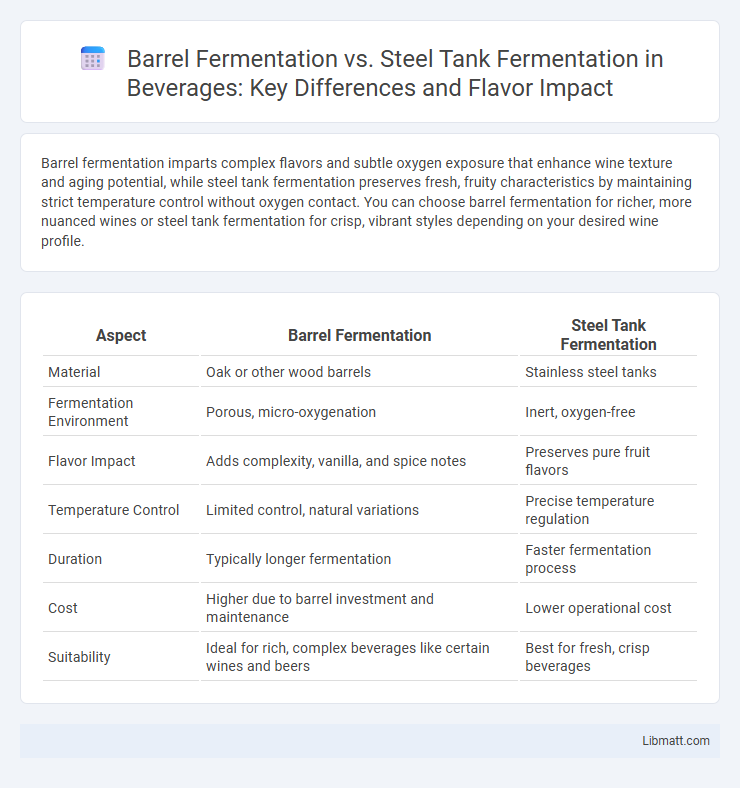Barrel fermentation imparts complex flavors and subtle oxygen exposure that enhance wine texture and aging potential, while steel tank fermentation preserves fresh, fruity characteristics by maintaining strict temperature control without oxygen contact. You can choose barrel fermentation for richer, more nuanced wines or steel tank fermentation for crisp, vibrant styles depending on your desired wine profile.
Table of Comparison
| Aspect | Barrel Fermentation | Steel Tank Fermentation |
|---|---|---|
| Material | Oak or other wood barrels | Stainless steel tanks |
| Fermentation Environment | Porous, micro-oxygenation | Inert, oxygen-free |
| Flavor Impact | Adds complexity, vanilla, and spice notes | Preserves pure fruit flavors |
| Temperature Control | Limited control, natural variations | Precise temperature regulation |
| Duration | Typically longer fermentation | Faster fermentation process |
| Cost | Higher due to barrel investment and maintenance | Lower operational cost |
| Suitability | Ideal for rich, complex beverages like certain wines and beers | Best for fresh, crisp beverages |
Introduction to Barrel and Steel Tank Fermentation
Barrel fermentation involves aging wine in oak barrels, which allow slow oxygen exchange and impart complex flavors such as vanilla, spice, and toast to the wine. Steel tank fermentation utilizes stainless steel tanks that provide precise temperature control and preserve the wine's fresh, fruity characteristics without adding any external aromas. You can choose barrel fermentation for richer, more textured wines or steel tanks for crisp, clean, and aromatic profiles.
Historical Background of Wine Fermentation Methods
Barrel fermentation, dating back to ancient Roman times, utilizes oak barrels that impart complex flavors and oxygen interaction, shaping traditional winemaking practices. Steel tank fermentation emerged in the 20th century, offering precise temperature control and preserving fresh fruit characteristics, revolutionizing modern wine production. Understanding these historical methods allows you to appreciate the evolution and impact of fermentation choices on wine style and quality.
Key Differences: Barrel vs Steel Tank Fermentation
Barrel fermentation imparts complex flavors and enhances micro-oxygenation, while steel tank fermentation preserves pure, fresh fruit characteristics with precise temperature control. You may prefer barrel fermentation for richer, oak-influenced wines or steel tanks for a cleaner, crisper profile ideal for white and sparkling wines. The choice impacts wine texture, aging potential, and stylistic expression.
Impact on Wine Flavor and Aroma Profiles
Barrel fermentation imparts complex flavors and aromas such as vanilla, toast, and spice due to the oak's interaction with the wine, enhancing texture and mouthfeel through micro-oxygenation. In contrast, steel tank fermentation preserves the wine's pure fruit characteristics and fresh acidity by minimizing oxygen exposure and preventing flavor alteration. Winemakers select fermentation vessels based on desired flavor profiles, with barrels adding richness and depth, while steel tanks maintain crispness and varietal expression.
Influence on Wine Texture and Structure
Barrel fermentation imparts a creamy, fuller texture and complex mouthfeel to wine due to micro-oxygenation through the oak, enhancing structure and softening tannins. Steel tank fermentation preserves the wine's crispness, purity of fruit flavors, and bright acidity, resulting in a leaner, more vibrant texture. The choice between barrel and steel fermentation significantly influences the wine's tactile sensation, with barrels contributing to richness and tanks emphasizing freshness and precision.
Oxygen Exchange and Its Role in Fermentation
Barrel fermentation allows controlled oxygen exchange through the wood's porous structure, promoting micro-oxygenation that enhances complexity and softness in the wine. Steel tank fermentation provides a sealed environment with minimal oxygen contact, preserving fresh and crisp fruit characteristics. Understanding how oxygen exposure in these vessels influences your fermentation process helps tailor the wine's style and aromatic profile.
Cost and Efficiency Considerations
Barrel fermentation involves higher costs due to expensive oak barrels and longer aging times, which can reduce production efficiency. Steel tank fermentation offers a more cost-effective solution, with lower maintenance expenses and faster turnover, enhancing overall productivity. Your choice between the two depends on balancing budget constraints with desired wine complexity and scale of production.
Sustainability and Environmental Impact
Barrel fermentation produces unique flavors through natural micro-oxygenation but involves higher resource consumption due to oak harvesting and barrel production. Steel tank fermentation offers greater sustainability with reusable, recyclable materials and lower energy requirements, minimizing environmental impact. Your choice influences carbon footprint and resource efficiency, with steel tanks generally promoting eco-friendly winemaking practices.
Choosing the Right Fermentation Method
Choosing the right fermentation method depends on the desired flavor profile and winemaking goals, where barrel fermentation offers enhanced complexity and subtle oak characteristics, while steel tank fermentation preserves crisp, fresh fruit flavors with precise temperature control. Barrel fermentation allows micro-oxygenation that softens tannins and adds texture, whereas steel tanks prevent oxidation, maintaining vibrant acidity. Your decision should align with whether you want a richer, fuller-bodied wine or a clean, fruit-driven style.
Conclusion: Barrel or Steel Tank—Which Is Best?
Barrel fermentation imparts complex flavors and subtle oxygen exposure that enhance wine texture and aging potential, while steel tank fermentation preserves fresh, fruity characteristics with precise temperature control for consistency. The choice depends on the wine style desired: barrels are ideal for rich, robust wines needing maturation, whereas steel tanks suit crisp, aromatic varieties requiring vibrant freshness. Winemakers often blend both methods to balance complexity and clarity, optimizing quality based on grape type and vintage conditions.
Barrel fermentation vs steel tank fermentation Infographic

 libmatt.com
libmatt.com